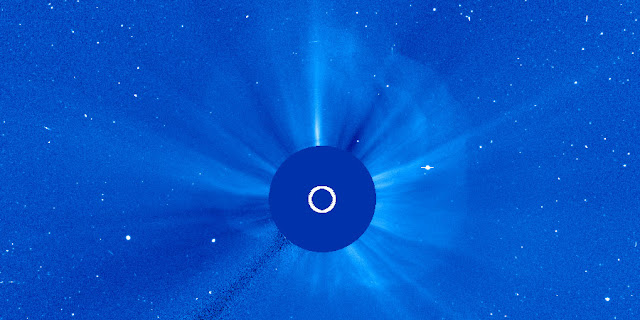We are still very much under the
influence of the 21 June coronal mass ejection that arrived yesterday
evening. The NOAA SWPC reported that the severe G4 geomagnetic storming
threshold was reached and the Wing Kp-index even went up to Kp9 which
stands for extreme G5 geomagnetic storm conditions, but the G5 reported
by the Wing-Kp is questionable. The disturbance storm time index
(another way of classifying geomagnetic storms where a lower number
means a stronger storm) reached -195nT (for now at least) which makes
this the second strongest geomagnetic storm of this solar cycle. The 2015/03/17 geomagnetic storm remains the strongest storm of this solarcycle with a Dst of -221 nT.
The direction of the IMF
remains south at the time of this post and more geomagnetic storming is
likely in the hours ahead. We have seen reports of vivid aurora
displays from many places around the world. If you also witnessed
an auroral display and made images or videos that you would like to
share with us feel free to send them in
to photos[at]spaceweatherlive.com. Thanks!Image: Aurora Borealis as seen from Viewmont, NY (USA) by Pete Mauney.
Image: Aurora Borealis as seen from Sparta, WI (USA) by Jacob Jones.
M6.6 coronal mass ejection analysis
Yesterday evening at the same time as the coronal mass ejection arrival, sunspot region 2371 erupted once more. This time it found the strength for an M6.6 (R2-moderate) solar flare that peaked at 18:23 UTC.It didn't took long to come to the conclusion that this M6.6 solar flare also launched a coronal mass ejection with an earth-directed component. More about that here in our news update from yesterday evening. SOHO imagery shows us a very nice halo coronal mass ejection which is guaranteed to arrive at Earth. The animations below from SOHO shows us the full expanding halo as the plasma cloud leaves the Sun.
Animations: SOHO/LASCO C2 and C3 coronagraph animations showing the M6.6 coronal mass ejection as it leaves the Sun.
While this coronal mass ejection does not expand like a perfect symmetrical halo event as the 21 June coronal mass ejection did (this coronal mass ejection has it's bulk heading a bit north-west) we still expect a very decent impact from this event as the full halo is still well defined.
CACtus reports a speed of about 1000km/s which is only a fraction slower than the coronal mass ejection of 21 June. Considering this coronal mass ejection is traveling trough a portion of space which has pretty much been cleared of ambient solar wind by the 21 June coronal mass ejection it is possible that this coronal mass ejection does not decelerate all that much. Using the same method that we used to predict the arrival time of the June 21 CME (which arrived close to our predicted arrival time) we come to the conclusion that this plasma cloud will arrive at Earth on Wednesday 24 June at 17:00 UTC with a plus/minus of 6 hours. The solar wind speed could again increase to about 700km/s and if the direction of the IMF again turns southward (Bz) we could again experience a strong G3 geomagnetic storm with aurora displays possible at middle latitude locations like southern England, Belgium and northern parts of Germany and Poland in Europe and many of the northernmost states in the USA. With a bit of luck, even sky watchers in southern parts of New South Wales in Australia will need to be alert for possible aurora displays.





No comments:
Post a Comment